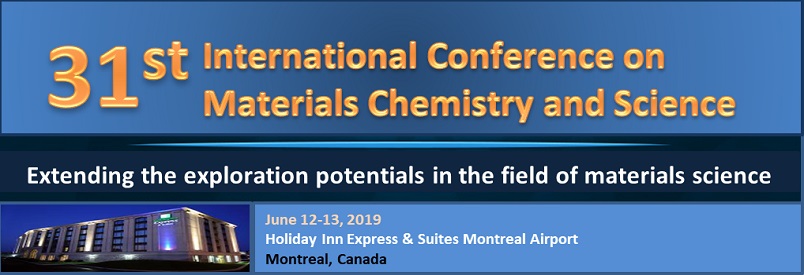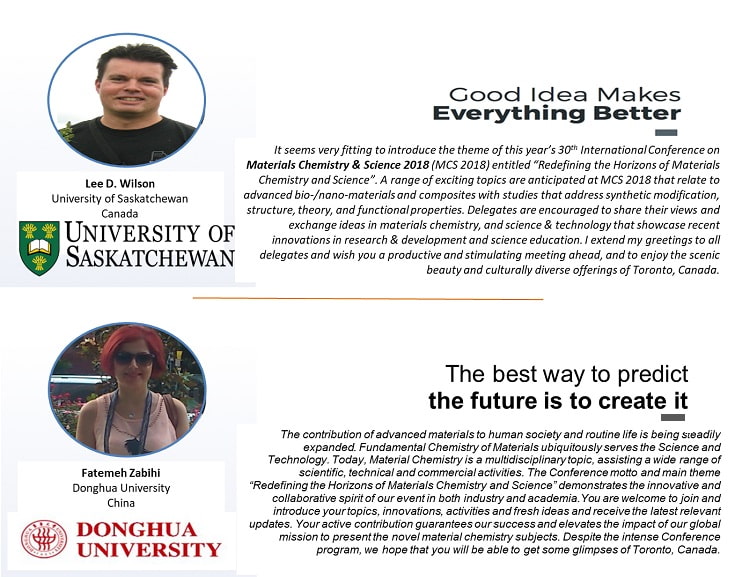The conference on Materials Chemistry & Science 2018 assures to serve as a great platform for the scientific community to meet the experts and exchange ideas. On the occasion of this huge gathering, organizing committee invites participants from all over the globe to take part in this annual meeting. The Conference will also have a space for companies and/or institutions to present their services, products, innovations and research results.
|
Conference Name |
Place |
Date |
|
MCS 2018 |
Toronto, Ontario, Canada |
August 27-28, 2018 |
Materials Chemistry provides the link between atomic, molecular and supramolecular behavior and the useful properties of a material. It lies at the core of many chemical-using industries. It involves the use of chemistry for the design and synthesis of materials with interesting or potentially useful physical characteristics, such as magnetic, optical, structural or catalytic properties. Research in materials chemistry and Science may focus on a discipline which could be a specific material. Some of the concerned points of research incorporate Computational Materials Science, Biomaterials, Ceramics, Composites, Photonics, and Functional Materials. Also due to the dramatic rise in the energy demands, researchers have started to focus on the energy materials for a better future.
Materials are crucial to monetary, social and mechanical improvement. Materials Science provides a comprehensive theoretical and practical review of advanced materials design and processing. The syncretic way of materials science and its complex qualities is drawing in numerous scientists and researchers towards this field for intense investigation. Modern society is heavily dependent on advanced materials: lightweight composites for faster vehicles, optical fibers for telecommunications and silicon microchips for the information revolution.
Importance and Scope
Materials science is evolving every day. With increasing urbanization and new generation demands for smart technology, better health security, wellness is impacting the market greatly; there is intense pressure on resources such as transportation, housing, energy and civil infrastructure and most especially the chemicals and materials industry to support developments across these sectors. Millions of chemical and material combinations create challenges for scientists when applying them to real-world applications that consumers touch every day.
The composites and polymers segment dominated the global lightweight materials market accounting for a market share of 30.4%, in 2015. Nanomaterials Market is expected to reach USD 55,016 million by 2022 from USD 14,741.6 million in 2015, supported by a CAGR of 20.7%. Research plays a unique role in this industry, driven by production costs (and ultimately the cost of the material to the market) perhaps more than any other industry examined.

Why Toronto, Canada?
Toronto is the leading tourism destination in Canada, attracting more than 25 million Canadian, American and international visitors annually. It is the provincial capital of Ontario and the fourth most populous city in North America after New York City, Mexico City, and Los Angeles.
Toronto is the center of the Greater Toronto Area (GTA) which is the most populous metropolitan area in Canada. A global city, it is an international center of finance, business, arts, culture, and is recognized as one of the most cosmopolitan and multicultural cities in the world.
Target Audience
Market Growth
The Global Lightweight Materials Market is expected to reach USD 196,299 million by 2022 from USD 144,613 million in 2015, with a CAGR of 4.2% during the forecast period, 2016â€2022. They are useful in various technological applications such as fabrication of microelectronic circuits, sensors, piezoelectric devices, fuel cells, coatings for the passivation of surfaces against corrosion, and as catalysts.
U.S. R&D spending on chemicals and advanced materials was USD 12 billion in 2014. Overall global R&D was slightly higher 4.7% rate to USD 45 billion in 2014.
The biomaterials market was valued USD 70.90 billion in 2016 and is anticipated to reach USD 149.17 billion by 2021 at a CAGR of 16.0%. In the coming years, the market is expected to witness the highest growth in the Asia-Pacific region.
3D Printing Materials Market is expected to reach USD 1,871 million from USD 578 million by 2022, supported by a CAGR of 18.3%. Polymers are the most widely used material in the 3D printing material market.

Product Segment Analysis

Metal alloys segment is predicted to exhibit remarkable growth rate among all types, followed by composites and polymers segment. The global market for water-soluble polymers was valued at around USD 35.7 billion in 2016. This market will grow from nearly USD 49.6 billion by 2022 from USD 37.4 billion in 2017 with a compound annual growth rate (CAGR) of 5.8% for the period of 2017-2022.
The significance of carbon-based nanomaterials has increased due to its unique combinations of chemical & physical properties, which involve electrical conductivity, thermal conductivity, high mechanical strength, and optical properties.
Regional Segment Analysis
Asia-Pacific is projected to register significant growth as compared to the saturated markets of North America and Europe.

Key Market Players
Key players include Cytec Industries Inc., ExxonMobil Corporation, SABIC, Bayer AG, ArcelorMittal SA, PPG Industries Inc., Toray Industries Inc., Novelis Inc., and Alcoa Inc., Royal DSM (Netherlands), BASF SE (Germany), Corbion N.V. (Netherlands), Covestro (Germany), Invibio Ltd. (U.K.), Carpenter Technology Corporation (U.S.), E.I DuPont de Nemours and Company, Evonik Industries AG (Germany), Berkeley Advanced Biomaterials, Inc. (U.S.), CAM Bioceramics BV (Netherlands), and Celanese Corporation (U.S.).
Other players in the value chain include: Henkel Corporation, LyondellBasell Industries N.V., Hexcel Corporation, SGL Group, ThyssenKrupp AG, Nippon Graphite Fiber Corporation, Mitsubishi Rayon Co. Ltd., UC Rusal, Aluminium Corporation of China, Zoltek Companies Inc. and others, Owens Corning Corporation, Rio Tinto Alcan Inc., China Hongqiao Group Ltd., Kaiser Aluminium, US Magnesium LLC, and A&S Magnesium Inc. among others.
Conclusion
The metal alloys dominated the global lightweight materials market in 2014 and are expected to maintain its lead throughout the forecast period. Increase in penetration of lightweight components and growth in production of aircraft modules to uplift the need for advanced composites is propelling the lightweight materials market growth. The high cost of materials such as metals and metal alloys are restricting its widespread penetration in sectors such as industrial, aerospace and defense, healthcare, automotive, energy, and others. Asia-Pacific is the most attractive market for the new entrants along with industry players on account of the increasing demand for materials the growing number of industries and increased expenditure towards technology research is expected to provide significant opportunities to the industry players.





